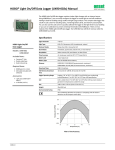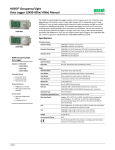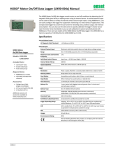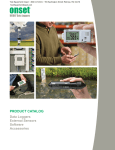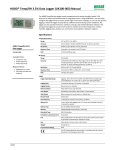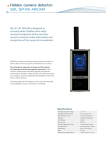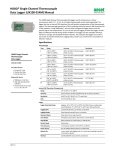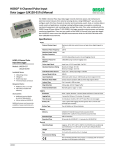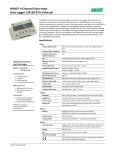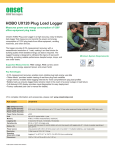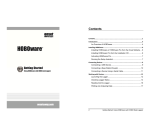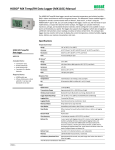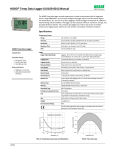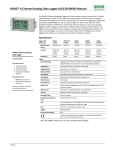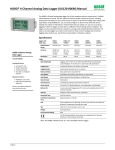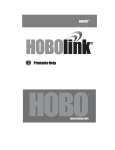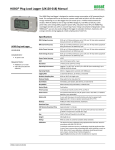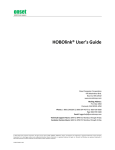Download HOBO State Data Logger (UX90
Transcript
HOBO® State Data Logger (UX90-001x) Manual The HOBO State/Pulse/Event/Runtime data logger records state changes, electronic pulses and mechanical or electrical contact closures from external sensing devices. Using HOBOware®, you can easily configure the internal magnetic reed switch or the external sensor to monitor and record data in a wide variety of applications, such as energy consumption, mechanical equipment operation, and water and gas flow. This compact data logger also has a built-in LCD screen to monitor logging status, battery use, and memory consumption. There are two models of the HOBO state logger: the UX90-001 has 128 KB of memory while the UX90-001M has 512 KB. Specifications Internal Sensor HOBO State Data Logger Maximum State, Event, Runtime Frequency 1 Hz Preferred Switch State No magnet present (normally open) External Input Models: UX90-001 UX90-001M External Contact Input Electronic solid state switch closure or logic driven voltage output Range 0 to 3 V DC (USB powered), 0 to 2.5 V DC (battery powered) Included Items: Maximum Pulse Frequency 50 Hz Maximum State, Event, Runtime Frequency 1 Hz Pulse, Event Lockout Time 0 to 1 second in 100 ms steps Solid State Switch Closure Input Low: < 10 KΩ; Input High: > 500 KΩ Internal Weak Pull-Up 100 KΩ Input Impedance Solid state switch closure: 100 KΩ pull up • • • • • 2.5 mm input cable Command™ strip Double-sided tape Hook & loop strap Magnet with 2 screws Required Items: • HOBOware 3.3 or later • USB cable (included with software) Accessories: • Wattnode kWh transducers • Power & Energy Meter (T-VER-E50B2) • Water Flow Meter Sensor (T-MINOL-130-NL) • U-Shuttle (U-DT-1) Additional sensors and accessories available at www.onsetcomp.com. Logger Resolution Pulse: 1 pulse, Runtime: 1 second, State and Event: 1 State or Event Logging Rate 1 second to 18 hours, 12 minutes, 15 seconds Memory Modes Wrap when full or stop when full Start Modes Immediate, push button, date & time, or next interval Stop Modes When memory full, push button, or date & time Time Accuracy ±1 minute per month at 25°C (77°F) (see Plot A) Power Source One 3V CR2032 lithium battery and USB cable Battery Life 1 year, typical with logging intervals greater than 1 minute and normally open contacts Memory UX90-001: 128 KB (84,650 measurements, maximum) UX90-001M: 512 KB (346,795 measurements, maximum) Download Type USB 2.0 interface Full Memory Download Time 10 seconds for 128 KB; 30 seconds for 512 KB Logger Operating Range Logging: -20° to 70°C (-4° to 158°F); 0 to 95% RH (non-condensing) Launch/Readout: 0° to 50°C (32° to 122°F) per USB specification LCD LCD is visible from: 0° to 50°C (32° to 122°F); the LCD may react slowly or go blank in temperatures outside this range Size 3.66 x 5.94 x 1.52 cm (1.44 x 2.34 x 0.6 in.) Weight 23 g (0.81 oz) Environmental Rating IP50 The CE Marking identifies this product as complying with all relevant directives in the European Union (EU). 15430-G HOBO State Data Logger (UX90-001x) Manual symbols illuminated on the LCD screen followed by definitions of each symbol in the following table. Specifications (continued) LCD Symbol Plot A: Time Accuracy The logger has been launched with a push button stop enabled; press and hold the Start/Stop button for 3 seconds to stop the logger. Note: If you also launched the logger with a push button start, this symbol will not appear on the display for 5 minutes. Logger Components and Operation Battery Tray Start/Stop Button Description The logger is waiting to be launched. Press and hold the Start/Stop button for 3 seconds to launch the logger. Unused Button The battery indicator shows the approximate battery power remaining. Reed Switch Mounting Loop If the logger has been configured to stop logging when memory fills, the memory bar indicates the approximate space remaining in the logger to record data. In this example, the logger memory is almost full. Mounting Loop If the logger has been configured to never stop logging (wrapping enabled), then a single block will blink starting at the left and moving right over time. Each block represents a segment of memory where the data is being recorded. In this example, the middle block is blinking. LCD Screen USB Port External Input Jack The switch is open or off. Start/Stop Button: Press this button for 3 seconds to start or stop logging data. This requires configuring the logger in HOBOware with a push button start or stop (see Setting up the Logger). You can also press this button for 1 second to record an internal event (see Recording Internal Logger Events) or to turn the LCD screen on if the option to turn off the LCD has been enabled (see Setting up the Logger). Note that the other button on the top of the logger is not functional for this model. The switch is closed or on. The logger is configured to record pulse or event data. The logger is currently logging. Time display when logger is logging: This shows the total amount of time the switch has been closed or on since logging began, ranging from seconds to days. This example indicates the switch has been closed or on for a total of 5 minutes and 38 seconds. The logger must be launched with the LCD set to show “Time” for this symbol to display. Battery Tray: Remove the battery tray (not visible in the diagram) on the top of the logger to access the logger battery (see Battery Information). Reed Switch: The internal reed switch (not visible in the diagram) inside the logger housing allows for monitoring when windows and doors are open or closed (see Using the Magnet). Time display when logger is stopped: This indicates the logger has been configured to start logging on a particular date/time. The display will count down to the start date/time until logging begins. In this example, 5 minutes and 38 seconds remain until logging will begin. Mounting Loops: Use the two mounting loops to mount the logger with the hook-and-loop strap (see Mounting the Logger). External Input Jack: Use this jack to attach the 2.5 mm input cable to an external sensing device (see Using the Input Cable). This shows the percentage of time the switch has been closed or on since logging began. This example indicates the switch has been closed or on for a total of 24% of the time since logging began. The logger must be launched with the LCD set to show “%” for this symbol to display. USB Port: Use this port to connect the logger to the computer or the HOBO U-Shuttle via USB cable (see Setting up the Logger and Reading Out the Logger). LCD Screen: This logger is equipped with an LCD screen that displays details about the current status. This example shows all 1-800-LOGGERS The logger has been stopped. 2 www.onsetcomp.com HOBO State Data Logger (UX90-001x) Manual Notes: second for a state change, but will only record a timestamped value when the state change occurs. One state change to the next represents the event duration. • You can disable the LCD screen when logging. Select “Turn LCD Off” when setting up the logger as described in the next section. When this option is enabled, you can still temporarily view the LCD screen by pushing the Start/Stop button for 1 second. The LCD will then remain on for 10 minutes. • Runtime. The logger checks the state of the switch once every second. At the end of each logging interval, the logger records how many seconds the line was in the logic low state. • When the logger has stopped logging, the LCD will remain on until the logger is offloaded to a computer or HOBO UShuttle (unless launched with the “Turn LCD Off” option). Once the logger has been offloaded and disconnected from the computer, the LCD will turn off automatically after 2 hours. The LCD will turn back on the next time the logger is connected to the computer. The external channel can be configured to log state or runtime as described above or the following: • Pulse. This records the number of pulse signals per logging interval (the logger records a pulse signal when the input transitions to the logic low). There are built-in scaling factors you can select for supported devices and sensors, or you can set your own scaling when you select raw pulse counts. Click the Advanced button to adjust the maximum pulse frequency and lockout time as needed (see Setting the Maximum Pulse Frequency and Lockout Time for more details). Note: Setting maximum pulse frequency to 50 Hz will reduce battery life. • If the pulse count exceeds 9,999 or -999, a second decimal point will be illuminated on the LCD to indicate the count has surpassed the 4-digit display. Setting up the Logger • Event. This records the date and time when a connected relay switch or logic low transition occurs (the logger records an event when the input transitions to the logic low). This is useful if you need to know when a switch closes, but the duration of the closure is not important. Click the Advanced button to adjust the lockout time to debounce switches as needed. Use HOBOware to set up the logger, including selecting the start and stop logging options, configuring the sensors, and entering scaling factors as necessary. It may be helpful to set up the logger to start at a specific date/time or with a push button stop and then bring it to the location where you will mount it to connect any external devices and test the connections before logging begins. 3. Configure optional filters as necessary. Click the Filters button to create additional filtered data series based on the sensor configuration. Any filtered series will be automatically available upon reading out the logger. 1. Connect the logger and open the Launch Logger window. To connect the logger to a computer, plug the small end of the USB cable into the side of the logger and the large end into a USB port on the computer. Click the Launch icon on the HOBOware toolbar or select Launch from the Device menu. 4. Set the units to display on the LCD screen. For State and Runtime sensors, select either Time or %. For external sensors, you can either use the default units or enter your own units up to three characters. 5. If the logger is configured to record pulse or runtime, choose a logging interval from 1 second to a maximum of 18 hours, 12 minutes, and 15 seconds. 6. Choose when to start logging: • Now. Logging begins immediately. • At Interval. Logging will begin at the next even interval (available when logging pulse or runtime). • On Date/Time. Logging will begin at a date and time you specify. • Push Button. Logging will begin once you press the Start/Stop logging button for 3 seconds. 7. Choose when to stop logging: Important: USB 2.0 specifications do not guarantee operation outside the range of 0°C (32°F) to 50°C (122°F). • When Memory Fills. Logging will end once the logger memory is full. • Never (Wrap When Full). The logger will continue recording data indefinitely, with newest data overwriting the oldest. 2. Configure the sensor. Choose either the internal or external sensor. Enter the name and select the state description as necessary or select the sensor type. Type a label for the sensor if desired. • Push Button. Logging will end once you press the Start/Stop logging button for 3 seconds. Note that if you also choose Push Button to start logging, then you will not be able to stop logging until 5 minutes after logging begins. The internal sensor can be configured to log: • State. This records how long an event lasts by storing the date and time when the state or switch changes (logic state high to low or low to high). The logger checks every 1-800-LOGGERS 3 www.onsetcomp.com HOBO State Data Logger (UX90-001x) Manual • Specific Stop Date. Logging will end at a date and time you specify. 8. Choose whether to keep the LCD on or off. By default, the LCD will always remain on while logging. If you select the “Turn LCD off” checkbox, the LCD will not show the current readings, status, or other information while the logger is logging. You will, however, be able to temporarily turn the LCD screen on by pressing the Start/Stop button for 1 second if you select this option. 9. Click the Start button to launch the logger. Disconnect the logger from the computer and deploy it using the mounting materials (see Mounting the Logger). After logging begins, you can read out the logger at any time (see Reading Out the Logger for details). Time Between Events Approximate Total Data Points Approximate Logging Duration (1 Year Battery Life) Logger Part Number 16 seconds to 4.25 minutes 63,488 11.76 to 187.38 days UX90-001 260,096 48.17 days to 2.1 years UX90-001M 4.26 to 68.25 minutes 50,790 150.49 days to 6.6 years UX90-001 208,077 1.69 years to 2.7 decades UX90-001M 68.26 minutes to 18.2 hours 42,325 5.5 years to 8.8 decades UX90-001 173,397 2.25 to 36.03 decades UX90-001M Notes: Using the Magnet (Internal Sensor) • Typical battery life is 1 year when state or event changes are at 1 minute or greater intervals. The logger contains an internal reed switch that can be used with the included magnet as the input to the logger. This configuration can be used to determine when a door or window is open or closed. The magnet must be oriented as shown below, positioned to the right side of the logger when the LCD screen is facing up. • The logger can record battery voltage data in an additional channel. This is disabled by default. Recording battery voltage reduces storage capacity and is generally not used except for troubleshooting. Internal reed switch Setting Maximum Pulse Frequency and Lockout Time When recording raw pulse counts, the logger dynamically adjusts its memory use from 4 to 32 bits instead of a typical fixed width. This results in the ability to store more data using less space, which in turn extends logging duration. The default pulse rate is 4 Hz; the maximum pulse frequency is 50 Hz. Decreasing the rate will increase logging duration. The following table shows examples of how pulse rate and logging interval affect logging duration. Using the Input Cable (External Sensor) The 2.5 mm input cable included with the logger can be used to measure contact closures and allows the logger to be mounted remotely from the contacts. Connect the contacts to the black and white wires, and plug the other end of the cable into the external input jack on the bottom of the logger. Do not connect the contacts to any other devices or cables. If the external sensor was configured to record raw pulse counts or events in HOBOware, there is also an option to specify lockout time. This can prevent false readings from mechanical contact closure bouncing. For more details on setting lockout time, see the HOBOware Help. 1 to 15 seconds 84,650 23.51 hours to 14.7 days UX90-001 346,795 4.01 to 60.21 days UX90-001M 1-800-LOGGERS Approx. Logging Duration Logger Part Number 1 min 4 8 126,976 88 days UX90-001 520,192 361 days UX90-001M 84,650 58 days UX90-001 346,795 240 days UX90-001M 50 12 1. Click the Advanced button from the Launch Logger window in HOBOware. The following table shows how memory capacity is affected by the amount of time between events: Approximate Logging Duration (1 Year Battery Life) Approx. Total Data Points You can change the maximum pulse frequency in HOBOware. In addition, you can also set a lockout time for raw pulse and event channels to prevent false readings from mechanical sensors as their relay state changes. To change the maximum pulse frequency or lockout time: The logger’s storage capacity and logging duration depends on the interval between state changes and events. The longer the interval between state changes, the more memory is needed to store each data point. Approximate Total Data Points Number Bits Required 1 min Determining Logging Duration Data Time Between Events Logging Interval Pulse Rate (Hz) 2. Select the sensor that corresponds with the pulse channel you wish to configure. Logger Part Number 3. Set the maximum pulse frequency (on raw pulse channels only) keeping in mind that the larger the pulse frequency, the shorter the logging duration will be. 4. Click the “Apply lockout time” checkbox if you wish to specify a time period when pulses will be ignored (only available for raw pulse channels and event channels). Select 4 www.onsetcomp.com HOBO State Data Logger (UX90-001x) Manual the lockout time value from 1 to 10. On sensors with both pulse frequency and lockout time settings, lockout time will affect the maximum pulse frequency: the higher the lockout time, the lower the maximum pulse frequency will be. Note: When lockout time is enabled, you can specify a value from 1 to 10 (with a default of 5), which is then multiplied by 100 milliseconds for a range of 0.1 to 1 second. The available range for the maximum pulse frequency is automatically recalculated based on the lockout time. For example, if the lockout time is set to 2, the maximum pulse frequency range changes to 0.01 to 5 Hz. Protecting the Logger The logger is designed for indoor use and can be permanently damaged by corrosion if it gets wet. Protect it from condensation. If the message FAIL CLK appears on the LCD screen, there was a failure with the internal logger clock possibly due to condensation. Remove the battery immediately and dry the circuit board. Note: Static electricity may cause the logger to stop logging. The logger has been tested to 8 KV, but avoid electrostatic discharge by grounding yourself to protect the logger. For more information, search for “static discharge” in the FAQ section on onsetcomp.com. Battery Information The logger is installed with a 3V CR2032 battery (HRB-TEMP). Expected battery life varies based on the ambient temperature where the logger is deployed, the logging interval, the rate of state changes and/or events, the frequency of offloading to the computer, and battery performance. A new battery typically lasts 1 year with logging intervals greater than 1 minute and when the input signals are normally open or in the high logic state. Deployments in extremely cold or hot temperatures, logging intervals faster than 1 minute, or continuously closed contacts may reduce battery life. Estimates are not guaranteed due to uncertainties in initial battery conditions and operating environment. 5. Click Save. Note that the selections will not take effect in the logger until you launch it. Reading Out the Logger There are two options for reading out the logger: connect it to the computer with a USB cable and read out it with HOBOware, or connect it to a HOBO U-Shuttle (U-DT-1, firmware version 1.15m030 or higher) and then offload the data files from the U-Shuttle to HOBOware. Refer to the HOBOware Help for more details. The logger can also be powered by the USB cable when the remaining battery voltage is too low for it to continue logging. Connect the logger to the computer, click the Readout button on the toolbar, and save the data as prompted. Replace the battery before launching the logger again. Recording Internal Logger Events To replace the battery: The logger records the following internal events (different from state/event changes) to help track logger operation and status: 1. Holding the logger with the LCD screen facing up, pull the battery tray out of the logger housing. Internal Event Name Definition Host Connected The logger was connected to the computer. Started The Start/Stop button was pressed to begin logging. Stopped The logger received a command to stop recording data (from HOBOware or by pushing the Start/Stop button). Button Up/Button Down The Start/Stop button was pressed for 1 second. Safe Shutdown The battery level dropped below 2.5 V; the logger performs a safe shutdown. Battery tray removed from logger 2. Remove the old battery from the tray. Mounting the Logger 3. Place the new battery in the tray with the positive side facing down. There are several ways to mount the logger using the materials included: • Attach the Command strip to the back of the logger to mount it a wall or other flat surface. CR2032 battery being placed in the tray, positive side facing down • Use the double-sided tape to affix the logger to a surface. • Insert the hook-and-loop strap through the mounting loops on both sides of the logger to mount it to a curved surface, such as a pipe or tubing. 1-800-LOGGERS 5 www.onsetcomp.com HOBO State Data Logger (UX90-001x) Manual 4. With the LCD screen still facing up, slide the tray back into the logger. The LCD should display “HOBO” briefly after correctly installing the battery. WARNING: Do not cut open, incinerate, heat above 85°C (185°F), or recharge the lithium battery. The battery may explode if the logger is exposed to extreme heat or conditions that could damage or destroy the battery case. Do not dispose of the logger or battery in fire. Do not expose the contents of the battery to water. Dispose of the battery according to local regulations for lithium batteries. HOBOware provides the option of recording the current battery voltage at each logging interval, which is disabled by default. Recording battery life at each logging interval takes up memory and therefore reduces logging duration. It is recommended you only record battery voltage for diagnostic purposes. 1-800-LOGGERS (564-4377) • 508-759-9500 www.onsetcomp.com • [email protected] © 2012–2015 Onset Computer Corporation. All rights reserved. Onset, HOBO, and HOBOware are trademarks or registered trademarks of Onset Computer Corporation. All other trademarks are the property of their respective companies. 15430-G






